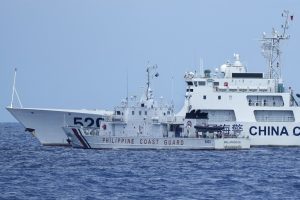The U.S. government has called on China to cease the “harassment and intimidation” of Philippine vessels, after the Philippine Coast Guard (PCG) reported another dangerously close encounter with Chinese vessels in a disputed part of the South China Sea.
“Imagery and video recently published in the media is a stark reminder of PRC harassment and intimidation of Philippine vessels as they undertake routine patrols within their exclusive economic zone,” U.S. State Department spokesperson Matthew Miller said in a statement.
“We call upon Beijing to desist from its provocative and unsafe conduct. The United States continues to track and monitor these interactions closely.”
The statement came a day after the PCG said it was involved in a near-collision with two Chinese vessels in the South China Sea – just the latest in a line of worrying close encounters between Chinese and Philippines ships in disputed waters.
Commodore Jay Tarriela, the PCG spokesperson for the West Philippine Sea, said in a statement that the incident took place on April 23, when two Chinese Coast Guard (CCG) vessels intercepted two PCG ships in the vicinity of Second Thomas Shoal. The Philippine-occupied feature lies about 105 nautical miles west of Palawan island, inside the Philippines’ exclusive economic zone (EEZ).
Tarriela said the vessel carried out “dangerous maneuvers” near the BRP Malapascua, “maintaining a perilous distance of only 50 yards.” He added that the incident posed a “significant threat to the safety and security’ of the Philippine vessel and its crew.
The encounter came on the sixth day of a weeklong PCG patrol of the South China Sea, part of Manila’s policy of identifying and publicizing Chinese incursions into the Philippines’ EEZ.
According to a report by Jim Gomez of the Associated Press, who was among a group of journalists who were invited to accompany the PCG on its patrol, the Philippine vessels were approaching Second Thomas Shoal in order to conduct an underwater survey when the CCG repeatedly warned them by radio to leave the area. After that, Gomez reported,
A Chinese coast guard ship rapidly approached and shadowed the smaller Malapascua and the Malabrigo. When the Malapascua maneuvered toward the mouth of the shoal, the Chinese ship suddenly shifted to block it, coming as close as 36 to 46 meters (120 to 150 feet) from its bow, said Malapascua’s skipper, Capt. Rodel Hernandez. To avoid a collision, Hernandez abruptly reversed his vessel’s direction and then shut off its engine to bring the boat to a full stop.
The incident is just the latest in a string of encounters between CCG vessels and Philippine ships in recent months, in which China has harassed navy and PCG patrols and driven away fishermen from waters around Philippine-claimed features. China claims all of these areas, and much of the South China Sea, under its “nine-dash line” claim.
These included one incident in February involving the Chinese use of a military-grade laser to ward off a ship seeking to resupply Philippine forces stationed at Second Thomas Shoal. (The CCG also had a near-collision with a Vietnamese vessel inside Vietnam’s EEZ in late March.)
Indeed, in its statement on Friday, the PCG disclosed that during its seven-day patrol, which concluded on April 24, it identified “over 100 alleged Chinese Maritime Militia vessels, a People’s Liberation Army Navy corvette class, and two China Coast Guard vessels.”
Whether or not Chinese incursions have actually increased is hard to say. Since the PCG has made an explicit pledge to publicize these incursions more widely, it is possible that they’re simply getting more press attention. But it is nonetheless clear that China has not reined in its aggressive policy toward the Philippines. In fact, after six years under President Rodrigo Duterte in which the Philippines mostly downplayed the disputes in the South China Sea, they are once again the main point of friction in the China-Philippines relationship, which has been both a cause and effect of President Ferdinand Macros Jr.’s rapid recent development of security relations with the United States.
Indeed, the U.S. statement came as Marcos prepared to make his first official visit to Washington today. Prior to his departure, the Philippine leader called for the final adoption of a Philippines-China “direct communication line” in order to manage the disputes in the South China Sea, something that he agreed with China’s leader Xi Jinping during a visit to Beijing in January.
Similar cooperative noises were made by China’s foreign minister Qin Gang during a visit to the Philippines for talks on regional security last week. During the meeting, Qin said that China was willing to work with the Philippines to resolve the two nations’ differences, including the disputes in the South China Sea.
Given the situation offshore, however, there is a lot that Beijing would have to do to convince Philippine policymakers that it is willing to engage on these issues in good faith.

































